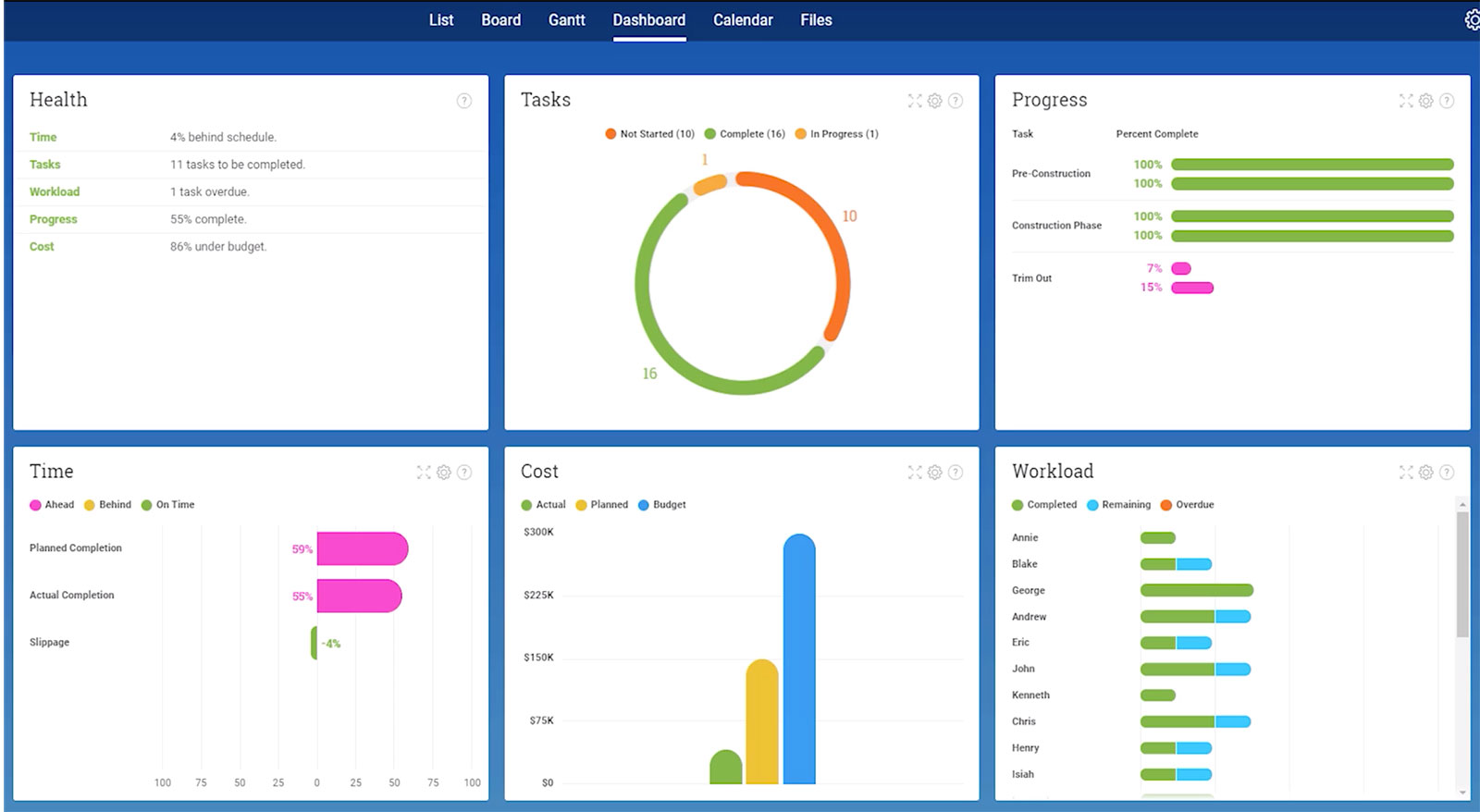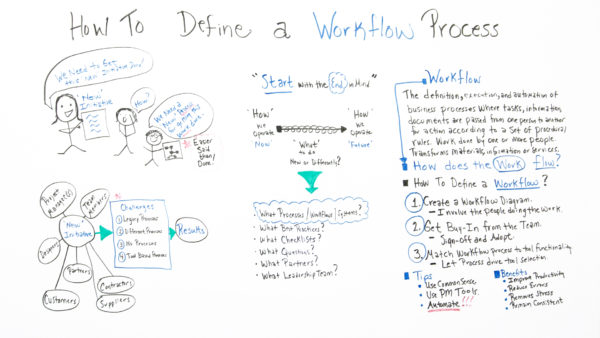Wondering how you’re going to get that project done? First you need to define a workflow process. Read on to learn how.
What Is a Workflow Process?
Workflow is the definition, execution and automation of business processes: where tasks, information and documents are passed from one person to another for action according to a set of procedural rules. It involves work by one or more people, and transforms materials, information or services.
How do you get a new initiative done? You need a process for getting through the work, which is easier said than done. That’s because there are a lot of different people and perspectives embedded in every new initiative. There are project managers, team members, designers, customers, partners, contractors, project management tools, supplies, etc.
That creates challenges, such as:
- Legacy Processes: If things were done a certain way in the past, it can be hard to change people’s behaviors.
- Different Processes: Third parties, vendors and other contractors you work with might have different processes.
- No Processes: There might be no process in place at all.
- Tool-Based Processes: Some might have a process, but one that is wedded to a tool, which restricts flexibility and possibly results.
Start with the End in Mind
When you’re first thinking about a workflow, you want to start with the end in mind. That is, look towards the end goal and then work backwards, so you can figure out the right path to get there. This will help you determine your workflow process.
From this perspective, you’ll want to ask yourself some questions, such as: what are the processes, workflows and systems needed to reach the endpoint in the project, and what are the best practices to employ? You’ll want to create a checklist, and ask questions. Note who you’ll partner with, and decide what leadership team will drive the whole endeavor.
How to Define Your Workflow
Here are three tips for defining a workflow for your project.
- Create a realistic workflow diagram, and involve the people doing the work.
- Get buy-in from the team, have them sign-off, and then adopt the plan for the project.
- Match workflow process to a tool functionality so that the process drives the tool selection, and not the other way around.
The benefits of following this course are that it will improve your productivity, reduce errors as you’re working on the project, help relieve the stress and keep you consistent.
How to Optimize Your Workflow Process
Once you’ve defined your workflow, you’ll want to make it more efficient. One way to do this is through automation. It will help to streamline the internal workflow by getting rid of much of the manual data entry and request handling.
Automation will also allow you to track the status of tasks, such as if they’re completed, pending or in-progress. If your software is cloud-based like ProjectManager.com, then those status updates are recorded in real-time, adding further efficiencies.
Software with automation features can also help teams stay on task. When a status is late or a deadline is looming, an automated notification can be emailed to the team member responsible for that task. Just as important, when the task is completed, the team is notified, helping to smooth the transition from one task to another.
Analyze Your Workflow
By working to identify trends in the performance of your workflow, both in the teams and team members involved, you can tighten up the loose ends over time. One way to do that is by identifying the process redundancies and eliminating them. Software will help you analyze your processes as well.
How ProjectManager.com Improves Workflow Process
ProjectManager.com is a cloud-based project management software that automates much of the manual labor to make your workflow more productive. Our software alerts assigned team members when deadlines are approaching, making sure that everyone is aware of the schedule and keeps the project on track.
We have the features that add efficiencies to workflow, like kanban boards that visualize workflow. Like a traditional kanban board, you can have three columns: to do, doing and done. Under each of these are cards, which are the individual tasks that can be assigned to team members. These cards can be tagged for easy filtering. Comments can be added and documents attached for better collaboration.
Cards can be expanded to show even more detail about the task. The expanded view shows hours worked, and you can create a to-do list and much more. If you want to pull in another team member who isn’t assigned to the task, just @ them and they’ll be notified by email.

Workflow must be analyzed to optimize it, and ProjectManager.com has you covered there, too. You can see how your project is progressing in real-time with our project dashboard. It tracks all your tasks in one view, showing you the percentage complete. You can also view your team’s workflow and monitor their progress.

ProjectManager.com has the tools to do this and so much more when planning, tracking and reporting on your project. See how it can help with your workflow and more by taking this free 30-day trial today.
Watch this Video to Learn More About Workflow Process
ProjectManager.com has tutorial videos to expand on our large library of blog posts on every aspect of project management. In this short training video Jennifer Bridges, PMP, defines what a workflow process is.
Here’s a screenshot for your reference!

Thanks for watching!
Transcription:
Today we’re talking about how to define a workflow process. Well, often when you manage a new initiative or new project you have to define a new process for getting the work done.
Well, that’s easier said than done sometimes. If you look at a new initiative or new project there are multiple players involved so you may have a project manager or multiple project managers, you have different team members, many times you have designers, partners, customers, contractors, and even suppliers.
And with that some of the challenges that occur are you’re dealing with legacy processes, maybe things that were done in the past, so sometimes people kind of hold on to the way it used to be. And then you had different processes so especially if these are third parties or maybe vendors, they have their own process.
So trying to get everybody talking in the same language or doing things the same way is difficult. And then sometimes some of these players have no processes at all, and then some people have their processes designed according to the tool which makes it difficult at times to get the results.
So when we’re designing a workflow process we wanna start with the end in mind. So what does that mean? We take a look at how we operate now versus how we wanna operate in the future. And so we need to look at, what do we need to do new or differently?
So some of the things we wanna look at are defining what the processes, workflows, and systems look like, best practices, checklist, what questions do we need to be asking, what partners do we need to have on board, and what does our leadership team need to look like. But today, in today’s whiteboard session, I wanna focus on the workflow.
So let’s start by looking at what a workflow really is. It’s the definition, execution, and automation of business processes where task, information, and documents are passed from one person to another according to a set of procedural rules. And the work can be done by one or more people and it transforms materials, information, or services. Basically, we’re looking at how does the work flow?
So let’s talk about how we define one. So this is at a very high level, but the three main steps are first of all, create a workflow diagram. So it’s literally a diagram of how that work passes from one person to another, or from one group to another. And, of course, you can imagine that can get at a very detailed level. But the important thing to remember is to involve the people who are doing the work so it’s realistic.
And then second of all, once you get the diagram completed you want to socialize that with the entire team and make sure there’s buy-in, make sure there’s no gaps, and make sure, again, it’s realistic. You want everyone to sign off on the process and adopt it and implement it across the project or initiative.
And then on the third one, match the workflow process to tool functionality. In here we wanna let the process drive the tool. But again, sometimes people say, “Well, that’s not in the real world,” because a lot of times that tool is selected by or already used by a corporation. But with that we wanna use common sense.
We also want…you can see how important project management tools are. And with that by using the tools we wanna automate as much as possible. So, therefore, the people doing the work can do what they do best and that’s the work. And then…so what’s the benefits of all of this? It really improves productivity, it reduces errors, it removes stress and keeps things consistent among the initiative or the project.
So if you need a tool that can help you with your workflow process then sign up for our software now at ProjectManager.com.
(This post was updated December 2019)

No comments:
Post a Comment